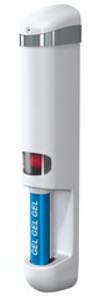While many of us are keeping our heads down self-isolating, there are still a significant number of people who don't have that safety blanket. While rigorous hygienic standards are already in place, new practices are required to help allay the anxieties of those having to spend their working days within the (often) cramped confines of cleanrooms and labs.
So, what can be practically done to minimise the coronavirus risks for teams?
Accounting for airborne
COVID-19 creates a conflict of priorities in relation to air flow in cleanroom design and build, with the issue being that SARS-CoV-2 is detectable in the air for up to three hours. The priority in hygiene-controlled areas is to keep particle counts within set levels to comply with ISO classes. However, frequent air changes mean the air is very active, which could be actively increasing risk.
There could be safe compromises to be made. Simple changes can be made to allow for reduced air change rates, whilst maintaining safe particle counts. This doesn't have to be rocket science, it all comes down to air flow management and ensuring your air flow vents are not blocked by furniture.
SARS-CoV-2 is detectable in the air for up to three hours
In these unusual times, it's well worth evaluating the placement of furniture to check it supports good flow throughout the cleanroom. The safest option will always be to remove any extraneous items and shelving. Where this isn't possible, choose furniture that will support air flow such as perforated tables and wired shelves.
Social distancing
Reducing the amount of furniture can also be the simplest way to allow for social distancing in rooms where space is at a premium. When this isn't an option, the most practical solution is to invest in mobile tables and chairs that can be easily moved to support the two-metre physical exclusion zone.
Deep cleans are a necessity throughout the building but the greatest area of risk is the gowning room
Cleanroom users are used to covering up so there should be no real problem in asking staff to don additional face masks, goggles and overalls. However, it's worthwhile reviewing whether you need to upgrade your PPE for even more body coverage; such as gloves sealed to the elbow or increasing the frequency of garment washing to give staff fresh gowns every day to reduce transference risks.
Coronavirus doesn't differentiate between cleanrooms, labs or any other part of the facility. Needless to say, regular deep cleans are a necessity throughout the building but the greatest area of risk is the gowning room. The space available for changing rooms is often very limited, this is where managing social distancing will be most challenging.
It makes sense to use hands-free options whenever possible
There are a number of simple hacks that can be employed to manage risk within the changing area itself - and most are common sense. First, install multiple PPE dispensers at distances greater than two-metres around the room, this discourages staff clustering around one area.
It is also worth considering staggered starts to shifts, so the changeover room can safely accommodate the number of people in it at any one time.

Sanitising door handle that releases viricidal gel on contact
Managing the human factor
Everyone is now much more aware of new hygiene risks than we were at the start of the year, with the new risks affecting personal health whereas before it was purely the end customer.
As we are all acutely aware, hand hygiene is all-important as the virus can be detectable on surfaces for up to 72 hours. High touch surfaces represent a particular risk factor. Hand sanitising gel should be installed at entrances and exits that aren't motion sensor-controlled. Ideally, standard handles should be replaced with sanitising door handles that release viricidal gel on contact.
Similarly, it makes sense to use hands-free options whenever possible, whether infrared or knee operated, for taps and soap dispensers.
While we all hope that we won't see another pandemic within our lifetimes, there is no guarantee. Businesses should use this period of heightened awareness to embed the highest levels of hygienic best-practice amongst staff.
N.B. This article is featured in the May 2020 issue of Cleanroom Technology. The latest digital edition is available online.





